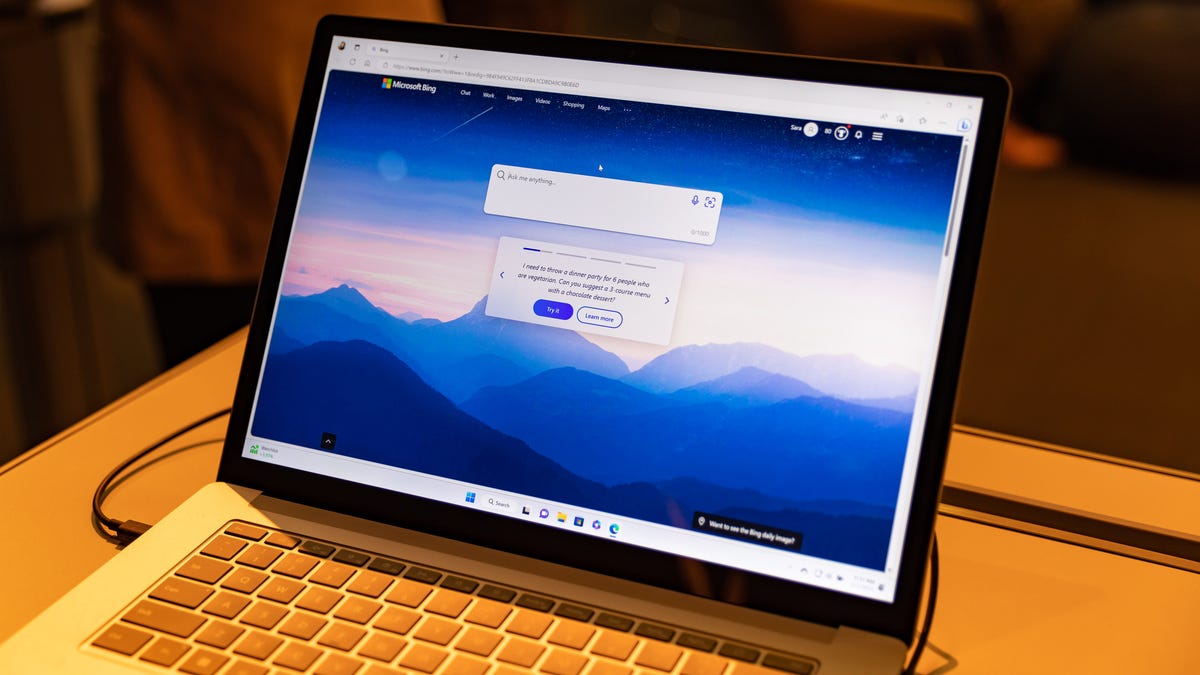Technologies
Microsoft’s New AI-Powered Bing: Here Are 5 Things You’ll Be Able to Do
Bing will refine search results, summarize topics and generate writing as your «co-pilot.»

Microsoft on Tuesday announced an enhanced Bing, detailing how it’s using the AI tech behind ChatGPT to add in a slew of new capabilities to the longtime second-place search engine. There’s a waiting list for the service now, and Microsoft says it will be available broadly in the coming months. There’ll be no charge for the service.
CEO Satya Nadella said the juiced-up search service aims to take on queries that aren’t getting good results on today’s search engines. People increasingly use search engines to get advice and information on complex topics, not just a link to a website, and the AI boost to Bing aims to make it more usable.
«It’s a new day in search,» Nadella said during the event on Tuesday.
ChatGPT, an AI-powered chatbot from a company called OpenAI, burst onto the scene in November with a breathtaking capacity for drawing information from the web and presenting it in plausible essays, poems and other formats. It set off an intense interest in AI that has captured the attention of millions, including the Big Tech players. Last month, Microsoft said it would be investing billions of dollars into the company. Meanwhile, Google, the dominant search engine on the web, on Tuesday announced Bard, its ChatGPT challenger.
Microsoft says its technology makes Bing your co-pilot on the web. Here’s a taste of what you can try out with the AI-powered search.
Search
You can search on Bing.com, as always. What’s new here is that Microsoft has applied OpenAI’s model to its search ranking engine. That led to a huge leap in the relevance of search results, the company says, so Microsoft believes you’ll find better responses to your basic searches on Bing.
The AI also augments the search results with written summaries. A use case Microsoft predicts will be popular is planning a trip. If you’re going to New Orleans for three days, for example, what should you do? A search on Bing will show you not just links to sites with sight-seeing and museum suggestions for the Big Easy, but also a sidebar with a summary of information from around the web, written by AI. The sidebar will link to sources that can let you explore further.
Ask for more details
If you want to ask more questions after your initial Bing search, you can click the chat icon near the top of the search page. Here you can refine the results. In the trip planning example, you can do things like clarify that you’re visiting New Orleans with kids, or ask for a three-day itinerary for your visit.
Bing can offer pretty fine-grained results in this conversational format. In addition to a detailed itinerary with descriptions of the places you’ll visit, you can ask for travel times between activities in New Orleans, for example.
This also applies to searching for advice on a home improvement project, like installing air conditioning in your house. If you clarify that you have air ducts in your home already, for example, it can give you information more relevant to your project.
Write something
The new Bing can write for you. After you research your home improvement project, for example, you ask Bing to write an email to your partner summarizing what you found. You can edit the writing, click into the text box of a new email and have Bing insert it there.
You can also ask Bing to write something with a fresh prompt, similar to many examples of ChatGPT’s writing that users have shared online recently. Anything from the whimsical «write a story about a curious dog who goes to the moon for preschoolers» to the more serious «write a letter to my apartment contesting an upcoming increase in rent» can generate text. You can also tweak the tone of the writing, like requesting it be funny.
Get context for a website
On the newly revamped Edge browser, you’ll be able to open a Bing sidebar and get more information about something you’re looking at online. You can open a product listing on Amazon, for example, and then open up the sidebar to ask Bing to tell you about the product. It’ll give you a summary of the product’s specs, cost and use cases.
For a specific iRobot vacuum, for example, you can also ask Bing for examples of reviews from cat owners. That’ll pull up quotes from Amazon reviews for the vacuum that mention cats and some summary from Bing.
You can also ask Bing to give you the key takeaways from a long document, and then compare it to another document.
Ask a broad question
If you’ve ever typed a query like «who are some famous Mexican painters?» into a search engine, you’re probably familiar with the experience of getting an excerpt from one website, a list of relevant people and a link to Wikipedia. The request is so broad that you typically have to leave the search page to get the answer. The new Bing wants you to stay, at least for a while.
Ask about Mexican painters on the new Bing and you’ll get a written summary of the key players and a description of their work. You can click on links to sources to learn more, if you like, or you can ask for more fine-grained results in the chat function.
Editors’ note: CNET is using an AI engine to create some personal finance explainers that are edited and fact-checked by our editors. For more, see this post.
Technologies
Today’s NYT Connections Hints, Answers and Help for Dec. 24, #927
Here are some hints and the answers for the NYT Connections puzzle for Dec. 24 #927

Looking for the most recent Connections answers? Click here for today’s Connections hints, as well as our daily answers and hints for The New York Times Mini Crossword, Wordle, Connections: Sports Edition and Strands puzzles.
Today’s NYT Connections puzzle is kind of tough. Ooh, that purple category! Once again, you’ll need to look inside words for hidden words. Read on for clues and today’s Connections answers.
The Times has a Connections Bot, like the one for Wordle. Go there after you play to receive a numeric score and to have the program analyze your answers. Players who are registered with the Times Games section can now nerd out by following their progress, including the number of puzzles completed, win rate, number of times they nabbed a perfect score and their win streak.
Read more: Hints, Tips and Strategies to Help You Win at NYT Connections Every Time
Hints for today’s Connections groups
Here are four hints for the groupings in today’s Connections puzzle, ranked from the easiest yellow group to the tough (and sometimes bizarre) purple group.
Yellow group hint: Cash out.
Green group hint: Chomp
Blue group hint: Walleye and salmon.
Purple group hint: Make a musical sound, with a twist.
Answers for today’s Connections groups
Yellow group: Slang for money.
Green group: Masticate.
Blue group: Fish.
Purple group: Ways to vocalize musically plus a letter.
Read more: Wordle Cheat Sheet: Here Are the Most Popular Letters Used in English Words
What are today’s Connections answers?
The yellow words in today’s Connections
The theme is slang for money. The four answers are bacon, bread, cheese and paper.
The green words in today’s Connections
The theme is masticate. The four answers are bite, champ, chew and munch.
The blue words in today’s Connections
The theme is fish. The four answers are char, pollock, sole and tang.
The purple words in today’s Connections
The theme is ways to vocalize musically plus a letter. The four answers are hump (hum), rapt (rap), singe (sing) and whistler (whistle).
Don’t miss any of our unbiased tech content and lab-based reviews. Add CNET as a preferred Google source.
Toughest Connections puzzles
We’ve made a note of some of the toughest Connections puzzles so far. Maybe they’ll help you see patterns in future puzzles.
#5: Included «things you can set,» such as mood, record, table and volleyball.
#4: Included «one in a dozen,» such as egg, juror, month and rose.
#3: Included «streets on screen,» such as Elm, Fear, Jump and Sesame.
#2: Included «power ___» such as nap, plant, Ranger and trip.
#1: Included «things that can run,» such as candidate, faucet, mascara and nose.
Technologies
Today’s NYT Mini Crossword Answers for Wednesday, Dec. 24
Here are the answers for The New York Times Mini Crossword for Dec. 24.

Looking for the most recent Mini Crossword answer? Click here for today’s Mini Crossword hints, as well as our daily answers and hints for The New York Times Wordle, Strands, Connections and Connections: Sports Edition puzzles.
Need some help with today’s Mini Crossword? I’m Irish-American, but yet 6-Down, which involves Ireland, stumped me at first. Read on for all the answers.. And if you could use some hints and guidance for daily solving, check out our Mini Crossword tips.
If you’re looking for today’s Wordle, Connections, Connections: Sports Edition and Strands answers, you can visit CNET’s NYT puzzle hints page.
Read more: Tips and Tricks for Solving The New York Times Mini Crossword
Let’s get to those Mini Crossword clues and answers.
Mini across clues and answers
1A clue: Wordle or Boggle
Answer: GAME
5A clue: Big Newton
Answer: ISAAC
7A clue: Specialized vocabulary
Answer: LINGO
8A clue: «See you in a bit!»
Answer: LATER
9A clue: Tone of many internet comments
Answer: SNARK
Mini down clues and answers
1D clue: Sharks use them to breathe
Answer: GILLS
2D clue: From Singapore or South Korea, say
Answer: ASIAN
3D clue: Large ocean ray
Answer: MANTA
4D clue: ___ beaver
Answer: EAGER
6D clue: Second-largest city in the Republic of Ireland, after Dublin
Answer: CORK
Don’t miss any of our unbiased tech content and lab-based reviews. Add CNET as a preferred Google source.
Technologies
Quadrantids Is a Short but Sweet Meteor Shower Just After New Year’s. How to See It
This meteor shower has one of the most active peaks, but it doesn’t last for very long.

The Quadrantids has the potential to be one of the most active meteor showers of the year, and skygazers won’t have long to wait to see it. The annual shower is predicted to reach maximum intensity on Jan. 3. And with a display that can rival Perseids, Quadrantids could be worth braving the cold to see it.
Don’t miss any of our unbiased tech content and lab-based reviews. Add CNET as a preferred Google source.
The show officially begins on Dec. 28 and lasts until Jan. 12, according to the American Meteor Society. Quadrantids is scheduled to peak on Jan. 2-3, when it may produce upwards of 125 meteors per hour. This matches Perseids and other larger meteor showers on a per-hour rate, but Quadrantids also has one of the shortest peaks at just 6 hours, so it rarely produces as many meteors overall as the other big ones.
The meteor shower comes to Earth courtesy of the 2003 EH1 asteroid, which is notable because most meteor showers are fed from comets, not asteroids. Per NASA, 2003 EH1 is a near-Earth asteroid that orbits the sun once every five and a half years. Science posits that 2003 EH1 was a comet in a past life, but too many trips around the sun stripped it of its ice, leaving only its rocky core. The Earth runs through EH1’s orbital debris every January, which results in the Quadrantids meteor shower.
How and where to see Quadrantids
Quadrantids is named for the constellation where its meteors appear to originate, a point known as the radiant. This presents another oddity, as the shower originates from the constellation Quadrans Muralis. This constellation ceased to be recognized as an official constellation in the 1920s and isn’t available on most publicly accessible sky maps.
For the modern skygazer, you’ll instead need to find the Bootes and Draco constellations, both of which contain stars that were once a part of the Quadrans Muralis. Draco will be easier to find after sunset on the evening of Jan. 2, and will be just above the horizon in the northern sky. Bootes orbits around Draco, but will remain under the horizon until just after 1 a.m. local time in the northeastern sky. From that point forward, both will sit in the northeastern part of the sky until sunrise. You’ll want to point your chair in that direction and stay there to see meteors.
As the American Meteor Society notes, Quadrantids has a short but active peak, lasting around 6 hours. The peak is expected to start around 4 p.m. ET and last well into the evening. NASA predicts the meteor shower to start one day later on Jan. 3-4, so if you don’t see any on the evening of Jan. 2, try again on Jan. 3.
To get the best results, the standard space viewing tips apply. You’ll want to get as far away from the city and suburbs as possible to reduce light pollution. Since it’ll be so cold outside, dress warmly and abstain from alcoholic beverages, as they can affect your body temperature. You won’t need any binoculars or telescopes, and the reduced field of view may actually impact your ability to see meteors.
The bad news is that either way, the Quadrantids meteor shower coincides almost perfectly with January’s Wolf Moon, which also happens to be a supermoon. This will introduce quite a lot of light pollution, which will likely drown out all but the brightest meteors. So, while it may have a peak of over 100 meteors per hour, both NASA and the AMS agree that the more realistic expectation is 10 or so bright meteors per hour.
-

 Technologies3 года ago
Technologies3 года agoTech Companies Need to Be Held Accountable for Security, Experts Say
-

 Technologies3 года ago
Technologies3 года agoBest Handheld Game Console in 2023
-

 Technologies3 года ago
Technologies3 года agoTighten Up Your VR Game With the Best Head Straps for Quest 2
-

 Technologies4 года ago
Technologies4 года agoBlack Friday 2021: The best deals on TVs, headphones, kitchenware, and more
-

 Technologies4 года ago
Technologies4 года agoVerum, Wickr and Threema: next generation secured messengers
-

 Technologies4 года ago
Technologies4 года agoGoogle to require vaccinations as Silicon Valley rethinks return-to-office policies
-

 Technologies4 года ago
Technologies4 года agoOlivia Harlan Dekker for Verum Messenger
-

 Technologies4 года ago
Technologies4 года agoiPhone 13 event: How to watch Apple’s big announcement tomorrow
